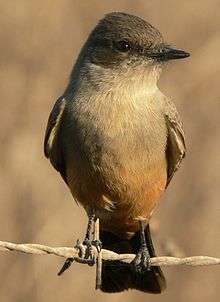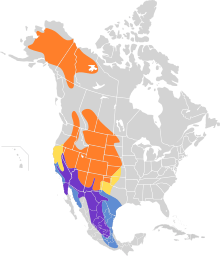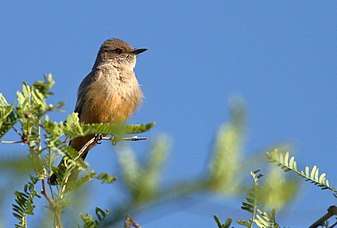Say's phoebe
Say's phoebe (Sayornis saya) is a passerine bird in the tyrant flycatcher family. A common bird in the western United States. It prefers dry, desolate areas. This bird was named for Thomas Say, the American naturalist.
| Say's phoebe | |
|---|---|
 | |
| Scientific classification | |
| Kingdom: | Animalia |
| Phylum: | Chordata |
| Class: | Aves |
| Order: | Passeriformes |
| Family: | Tyrannidae |
| Genus: | Sayornis |
| Species: | S. saya |
| Binomial name | |
| Sayornis saya (Bonaparte, 1825) | |
 | |
Description
The adult Say's phoebe is a drab, chunky bird. It is gray-brown above with a black tail and buffy cinnamon below, becoming more orange around the vent. The tail is long and the primaries end just past the rump on resting birds. The wings seem pale in flight and resemble a female mountain bluebird. The juvenile is similar to adult, but has buffy orange to whitish wingbars and a yellow gape. Adult birds are 7.5 in (19 cm) long. They have a 13 in (33 cm) wingspan and they weigh 0.75 oz (21 g).
Behavior
This bird is similar to the eastern phoebe. It sallies from a perch to catch insects in mid-air. It also hovers American kestrel-like and dips its tail while perched. The Say's phoebe also likes to feed just above the water's surface. They eat insects almost exclusively, but have been known to eat berries.
Habitat
These birds prefer dry, desolate, arid landscapes. They can be found on farmland, savanna and open woodlands, usually near water. They tend to be early migrants to the western U.S.

Range
They are found year-round from western Colorado, southwest to southern California, east to the western panhandle of Texas and south through western Mexico. They breed from Alaska south through western and south central Canada, south through North Dakota, the midwest and to New Mexico and westward. They winter in the desert southwest to southern Texas and south through Mexico to northern Central America. During migration these birds can be found thousands of miles out of range. There are regular fall reports in New England, U.S and Nova Scotia, Canada
Nesting
Say's phoebes nest in the typical phoebe fashion. They attach their nests under bridges, canyon walls, wells and abandoned mine shafts. The nest is made by the female and is cup-shaped. It is made of grass, forbs, moss and plant fibers lined with hair and other fine materials. She lays three to seven, but usually four or five, white, mostly unmarked, eggs. Some have red spots. The eggs are roughly 0.8 in (20 mm).
References
- BirdLife International (2012). "Sayornis saya". IUCN Red List of Threatened Species. 2012. Retrieved 26 November 2013.CS1 maint: ref=harv (link)
- Ted Floyd. Smithsonian Field Guide to the Birds of North America. 2008
- Paul R. Ehrlich, David S. Dobkin, Darryl Wheye. The Birder's Handbook. 1988
External links
| Wikimedia Commons has media related to Sayornis saya (Say's phoebe). |
| Wikispecies has information related to Sayornis saya |
- Say's phoebe species account - Cornell Lab of Ornithology
- Say's phoebe - Sayornis saya - USGS Patuxent Bird Identification InfoCenter
- "Say's phoebe media". Internet Bird Collection.
- Say's phoebe photo gallery at VIREO (Drexel University)
- Interactive range map of Sayornis saya at IUCN Red List maps
